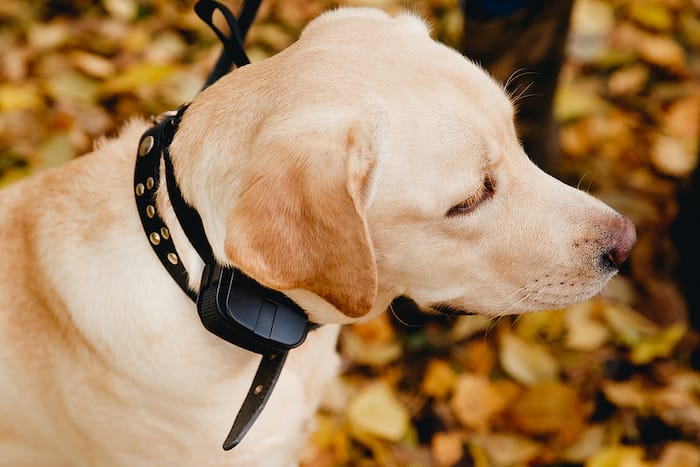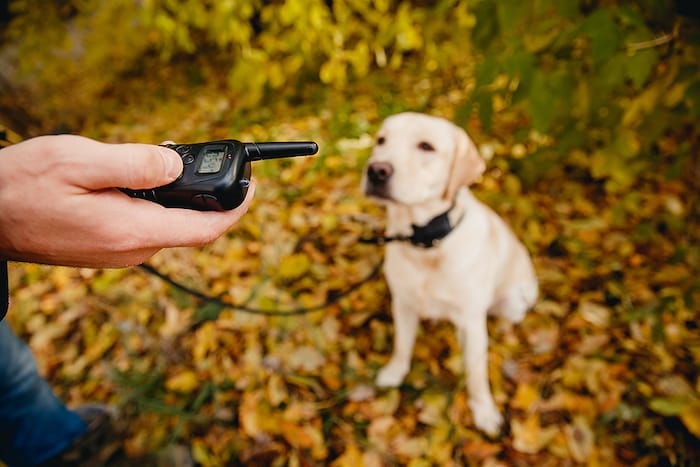Shock collars have been a topic of controversy for a long time between dog owners and dog trainers. But is a shock collar safe for your dog?
Shock collars are used for training your dog and correct their behavior. However, there are concerns they can harm your dog’s physical and mental health.
Hence, I have shared some insights on shock collars in this article based on thorough research and my experience. We will also dive into questions, pros, and cons you should consider while using this device.

So, without any further ado, let’s dive into the details!
Is a Shock collar safe for your Dog?
Shock collars can be safe and effective for your dogs if used correctly.
However, as mentioned previously, vets and dog lovers worldwide find this device risky and harmful. So, the debate over this controversy continues, as it might harm a dog.
On the other hand, some people believe that shock collars are safe, not work effectively if you use other correction modes like Vibration or beep mode.
Lastly, using the shock collars carefully and considering your dog’s well-being is more essential than pushing your dog unwillingly.
Factors to Consider Before Using a Shock Collar for Safety
Before discussing shock collars, many factors should be carefully considered for the well-being of your dog.
- Dog’s Age, Size, and Temperament
While using a shock collar, a dog parent should consider their dog’s age, size, and behavioral temperament to know how the dog will react to the collar.
Some dogs are strong enough to handle the shocks, whereas others are sensitive and can’t take the shock positively.
- Training Purpose and Alternatives
Evaluate the specific training goals you want to achieve. Positive reinforcement training methods often yield effective and long-lasting results without using aversive tools like shock collars.
- Proper Training Techniques
If you decide to use a shock collar, you must receive proper training on how to use it appropriately. Misuse of the device can exacerbate behavioral issues and lead to further complications.
- Consulting a Professional Trainer
Before opting for a shock collar, consulting with a certified professional dog trainer is highly recommended. They can help assess your dog’s behavior and recommend the most suitable and humane training approach.
- Positive Reinforcement Training vs. Shock Collars
Positive reinforcement training involves rewarding desired behaviors and ignoring or redirecting unwanted behaviors. This method builds a positive relationship between you and your dog, promoting trust and cooperation.
On the other hand, shock collars rely on punishment, which may temporarily suppress undesirable behaviors but do not address the root cause and may lead to involuntary consequences.
- Make use of safe technology options.
You can also opt for technology like GPS dog collars such as Halo Collar and Spot On Collar, whichever option suit your dog’s parenting needs the best. You will get better results while training your dog, along with an option to keep tabs on your dog.
Pros and Cons of a Shock Collar
Like any training tool, shock collars have advantages and disadvantages. Understanding these can help pet owners make informed decisions.
Pros:
- Shock collars can effectively get a dog’s attention and deter unwanted behaviors.
- Shock collars with remote control features offer convenience in managing your dog’s behavior from a distance.
- Some dogs may respond quickly to shock collar training, leading to faster behavior modification.
Cons:
- The potential risks of physical and psychological harm to the dog are significant concerns with shock collars.
- Improper use of shock collars can lead to fear and anxiety in dogs, which may worsen behavioral issues.
- They highly rely on punishment which may hinder the development of a strong bond between the dog and the owner.

Alternatives To Using A Shock Collar
It is debatable whether or not it is humane to use a shock collar on dogs because it may be harmful to their welfare. Alternative training techniques exist that are more beneficial, successful, and sensitive to the dog’s interest. The following are various alternatives for wearing a shock collar:
1. Positive Reinforcement:
Positive reinforcement training includes rewarding your dog for desired behavior with treats, compliments, or affection. Positive reinforcement strengthens your relationship with your dog and promotes positive behavior. For technology-oriented positive reinforcements, you can opt for some of the best vibrating dog collars available.
2. Clicker Training:
Using a small handheld clicker to record the precise instant your dog exhibits a desired behavior, clicker training is a type of positive reinforcement. The dog receives a treat or other incentive after the click, which helps the animal link the sound to good things.
3. Target training:
When teaching your dog to follow or touch a target, you can use a target pole or your hand as the target. This promotes collaboration and concentration while teaching commands and actions.
4. Desensitization and counterconditioning:
If your dog struggles with anxiety or fear, this method enables them to become accustomed to the stressor gradually. The dog can identify the trigger with joy rather than fear by associating it with pleasant experiences.
5. Training Games:
Include engaging activities in your dog’s training sessions to make it fun for both of you. Your dog will remain cognitively active and content by playing games like hide-and-seek, fetch, and puzzle toys.
6. Time-outs:
If your dog misbehaves, giving them a time-out in a calm, safe area might be a good approach to let them know that their conduct is unacceptable without turning to punishments.
7. Professional dog training programs:
Enrolling your dog in lessons emphasizing positive reinforcement can be a terrific way to guarantee that they receive the best instruction possible from qualified trainers. Sometimes, these professional trainers use bark collars and dog training collars to train the dogs with the best results.
8. Natural Repellents:
If your dog engages in undesirable activity, such as chewing on plants or furniture, utilizing natural repellents like bitter apple spray could help redirect his focus.

Final Verdict
The question of whether a shock collar is safe for your dog is not a straightforward one. While some dogs may respond well to shock collar training, the risks associated with its use cannot be ignored.
Safety and the well-being of your furry companion should always be the top priority.
While shock collars may offer quick results in dog training, their safety and ethics are subjects of ongoing debate.
Considering the potential risks and alternatives, dog owners must prioritize their pet’s well-being and explore positive reinforcement-based training methods that foster a strong bond and trust between them and their furry companions.
FAQs
- Are there any long-term effects of using a shock collar on a dog?
Some studies suggest that dogs subjected to shock collar training may develop behavioral issues and increased anxiety in the long run.
- Can shock collars replace professional training?
Shock collars should not replace professional training; they are best used under the guidance of experienced trainers.
- Are there any breeds that respond better to shock collar training?
The response to shock collar training can vary among breeds, but it is essential to remember that each dog is an individual.
Related Reading
